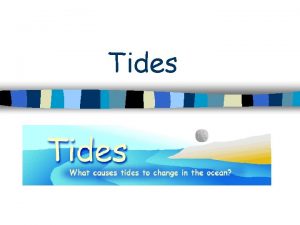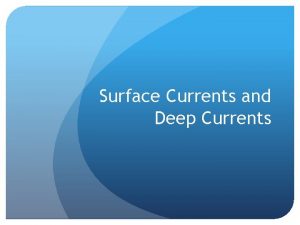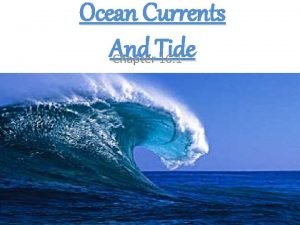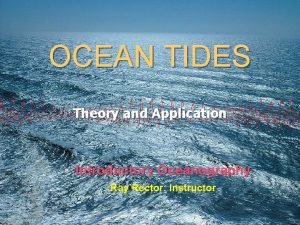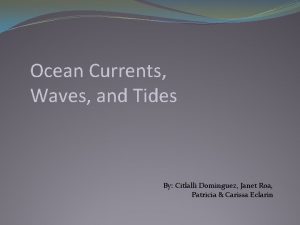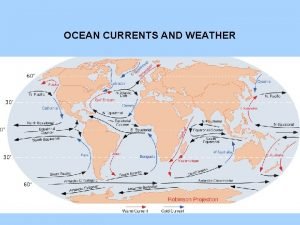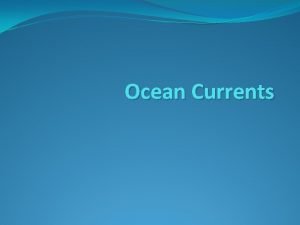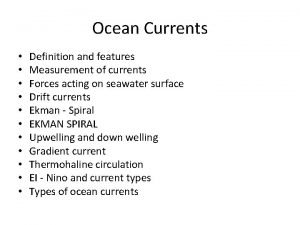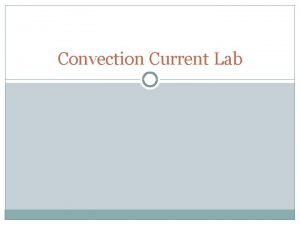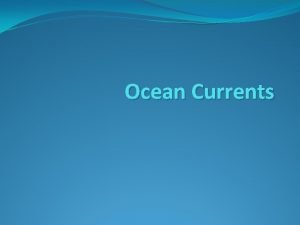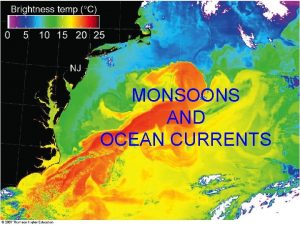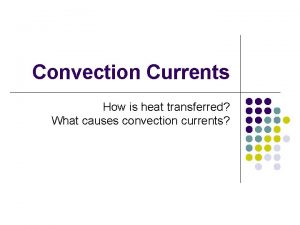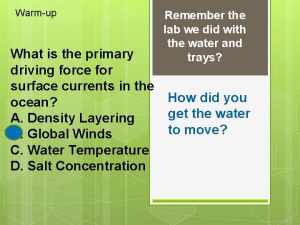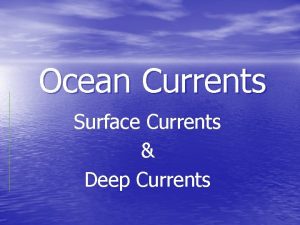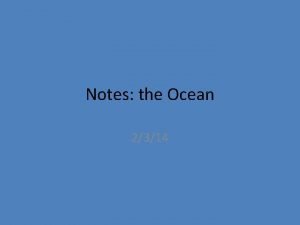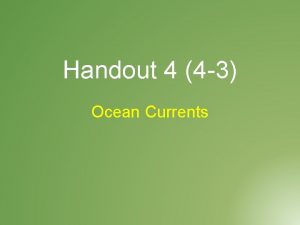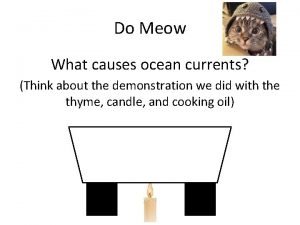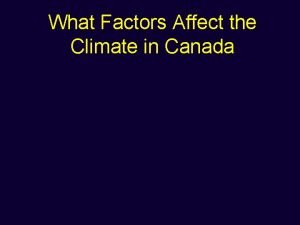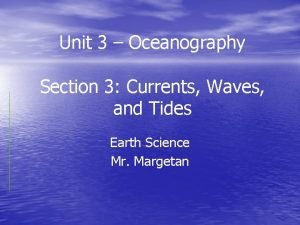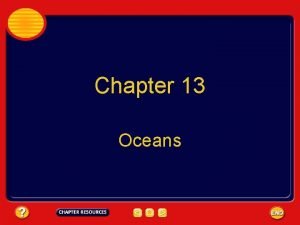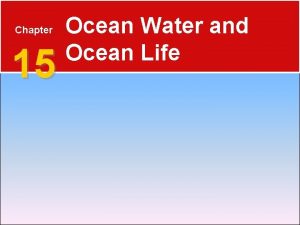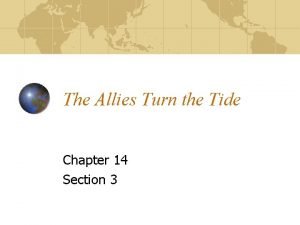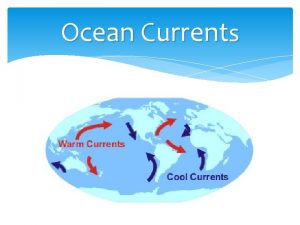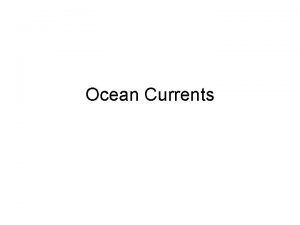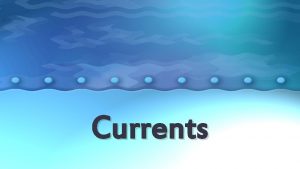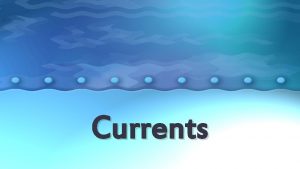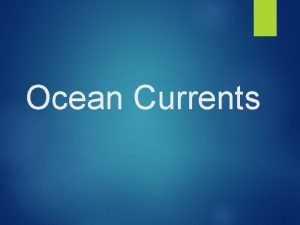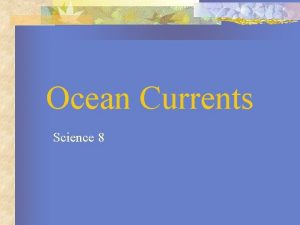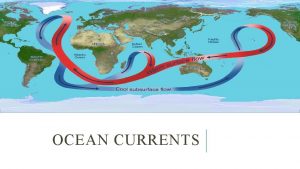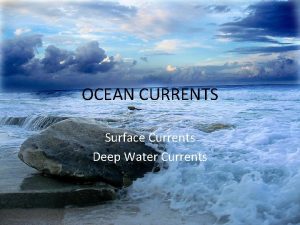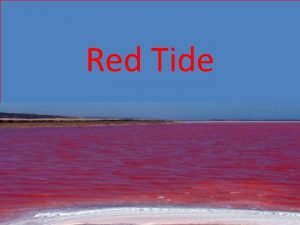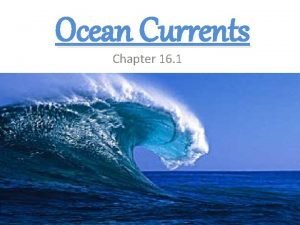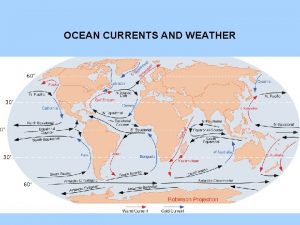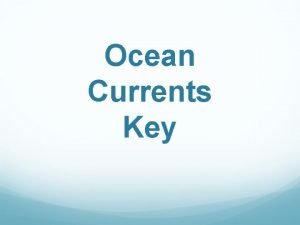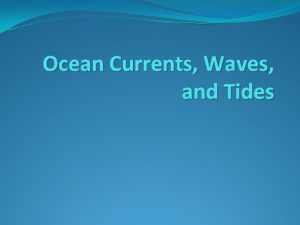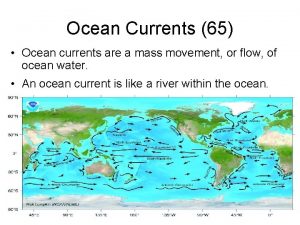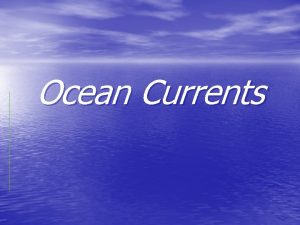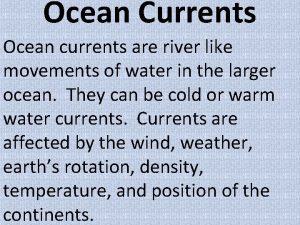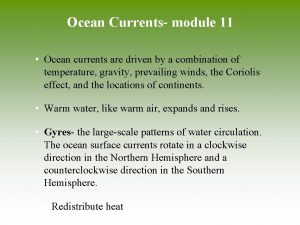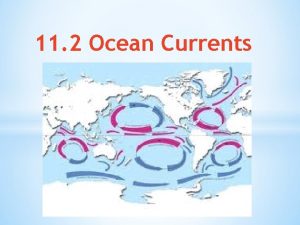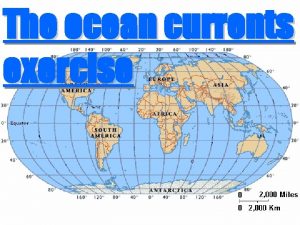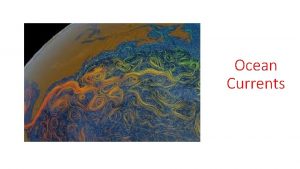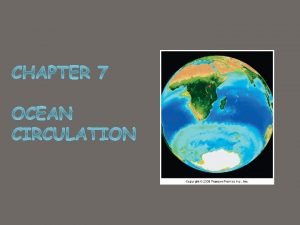Ocean Currents And Tide Chapter 16 1 Ocean




























- Slides: 28

Ocean Currents And Tide Chapter 16. 1

Ocean Currents • Masses of ocean water that flow from one place to another.

Currents • Two types of ocean currents: – Surface currents – Deep currents

Surface Currents that ONLY move horizontally in the UPPER part of the Oceans surface • Develop from friction between the ocean and the wind that blows across the surface.

Color your surface current map using the Key on your Surface Current Map! BLUE = Cold Current RED = Warm Current

Global Winds Create Currents Draw and Label a Global Winds Diagram according to this diagram.

Gyres • Huge circular-moving current systems that are driven by the global winds. • 5 main gyres!

Gyre Plastic Pollution

What if this was YOUR home?

Locate the 5 main Gyres on your surface current map. Label the Gyres on your map

Why? Great Britain and Alaska are at similar latitudes, yet Great Britain is about 25 degrees warmer than Alaska…

Ocean Currents and Climate Gulf Stream is a great example of bringing warmth to a high latitude. It brings heat from the equator region to areas more North and South

Deep Currents • VERTICAL (up and down) currents of ocean water • Caused by differences in water density • Cold Dense water SINKS • Warm LESS dense water RISES

Deep Currents • A result of temperature or salinity changes temp = sinks salinity = density sinks Color in your Global Conveyor Belt diagram

Tides Chapter 16. 2

What is a Tide? • The rise and fall of the sea level.

The gravitational pull of the Moon and the Sun make the tides

Sun Vs. Moon • The Sun is much larger than the Moon but has ONLY about ½ of the power of the Moon on tides WHY? Because the Moon is Closer

Types of Tides • Two types of tides: Spring Tides Neap Tides

Spring Tides • The Sun, Moon and Earth are in a straight line.

Spring Tides • Highest High Tides and Lowest Low Tides • Why?

Spring Tide • ALL Gravitational Force!!

Neap Tides • When the Sun Moon and Earth are at right angles.

Neap Tides • Tidal Range is the smallest. (NOT MUCH DIFFERENCE between high tide and low tide!) • Why?

Neap Tide Forces • TWO different forces • Gravitational and Centrifugal

In the boxes at the bottom of your notes Spring Tide vs. Neap Tide Spring Tide Force is all in one direction HIGHEST HIGHS & LOWEST LOWS Neap Tide Force is from two directions at the same time LOW HIGHS & HIGH LOWS


Tide Animations How Tides Work Time Lapse High Tide The Bay of Fundy https: //www. youtube. com/watch? v=5 oh. DG 7 Rq. Q 9 I https: //www. youtube. com/watch? v=s. MKvq. MUZw. V 4 https: //www. youtube. com/watch? v=OP 0 cp. Xpw 8 yk
 Spring tide and neap tide
Spring tide and neap tide What is deep current
What is deep current Types of tides
Types of tides The tide rises the tide falls meaning
The tide rises the tide falls meaning The tide rises, the tide falls
The tide rises, the tide falls Neap tide spring tide
Neap tide spring tide Neap tide spring tide
Neap tide spring tide Citlalli dominguez
Citlalli dominguez Ocean currents and weather
Ocean currents and weather Coriolis effect vocabulary
Coriolis effect vocabulary Ocean currents definition
Ocean currents definition Convection currents definition
Convection currents definition What causes wind to blow brainpop
What causes wind to blow brainpop Ocean currents
Ocean currents Ocean currents vocabulary
Ocean currents vocabulary Ocean currents
Ocean currents Cenozoic mammals
Cenozoic mammals What causes convection
What causes convection What is the primary driving force of surface ocean currents
What is the primary driving force of surface ocean currents Rubber ducks ocean currents activity
Rubber ducks ocean currents activity Ocean currents gulf of mexico
Ocean currents gulf of mexico What are ocean currents
What are ocean currents Surface ocean currents
Surface ocean currents What are ocean currents
What are ocean currents What factors affect the weather
What factors affect the weather Ocean currents
Ocean currents Ocean currents
Ocean currents Chapter 15 ocean water and ocean life answer key
Chapter 15 ocean water and ocean life answer key Turn the tide chapter 1
Turn the tide chapter 1
